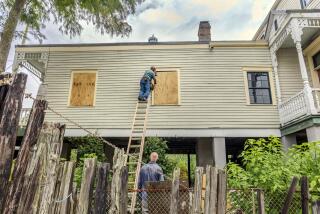How a tough Cajun town gets ready for a certain flood
The water is coming.
Ivy St. Romain could see it lapping against the boat ramp behind his house along Bayou Long, so dark and green he could barely make out the ragged tips of sunken cypress trees.
“Yeah, it’s coming,” he said, “but I’m not going. I’m staying right here.”
As the murky waters of the Atchafalaya River Basin slowly rise and threaten to swallow tiny Stephensville, population 1,433, most Cajuns who dominate this picturesque bayou town are hunkering down to fight the impending flood.
Photos: Mississippi River flooding wreaks havoc in the South
St. Romain, a fishing guide who owns Ivy’s Tackle Box just down the road, surrounded his house with sandbags. He and his wife, Joe, stocked up on canned food and venison and hauled out their generator and ice chests.
They’re counting on a barge to save the town — a 500-foot-long, 38-foot-high barge sunk into nearby Bayou Chene this week. Heavy pylons pounded it snugly into place, and 200 feet of metal sheet pilings were driven into the bottom to seal off the 700-foot-wide bayou. The goal is to divert backwater into the Gulf of Mexico rather than allow it to rise and inundate Stephensville as floodwaters from the Atchafalaya River pour into the basin like bathwater into a tub.
Authorities have opened floodgates at the Morganza Spillway, about 75 miles north of Stephensville, to prevent flooding downstream at Baton Rouge and New Orleans. Stephensville sits at the bottom of the Atchafalaya River Basin, surrounded on three sides by water. Once nearby marshes, bayous and lakes fill with runoff, water will back up into Stephensville — unless Bayou Chene is blocked.
“It’ll save us – if it works,” said Guy Cormier, president of St. Martin Parish, which includes Stephensville.
But if the contraption doesn’t hold, or if the area gets heavy rains that would be blocked from entering Bayou Chene, “Well, we could end up flooding ourselves,” he said.
In that case, Cormier said, he’d be obliged to order a mandatory evacuation.
Joe St. Romain considers the barge Stephensville’s salvation.
“I figure that barge will save a foot and a half of water from coming into my house,” she told a slender man standing in her backyard.
The man happened to be Bobby Jindal, Louisiana’s governor. He flew in Tuesday afternoon as Stephensville residents fortified their homes with plastic sheeting and 400,000 sandbags.
“When the water gets this close, every inch matters,” the governor told her.
Earlier, as Jindal stood next to prison inmates filling sandbags, he praised Stephensville for resilience and ingenuity. But he warned that the town needed to prepare for the worst.
“Bottom line, there’s a lot of water headed this way,” he said.
Farther north, the potential for flooding was so great that the Coast Guard closed a 15-mile stretch of the Mississippi River at the port in Natchez, Miss. Officials feared that barge traffic would increase pressure on levees downstream and that barges could not operate safely on the fast-rising river. Late in the day, the Associated Press reported, part of the river reopened.
Heavy spring rains and snowmelt have gorged the Mississippi, breaking river-level records that have held since the 1920s in some places. The opening of the Morganza Spillway, which began Saturday, was inundating a 20-mile swath of bayou country stretching 100 miles, threatening 20,000 to 25,000 people with up to 20 feet of water.
In Stephensville, any resentment toward Baton Rouge or New Orleans was sublimated by bitterness at a flood-control system only partially completed after a devastating flood in 1973 — the last time the Morganza Spillway was opened. The missing link in the federally funded project is a lock system to control backwater in Bayou Chene — hence, the sunken barge.
“We saved y’all’s butts down there in New Orleans,” Sam Jones, a state legislator who represents Stephensville, joked to a reporter.
Most people here are grudgingly willing to sacrifice for the safety of much larger cities, Jones said. But in return, the town should have a lock system to complete a network of levees and floodwalls, he said.
Either way, Stephensville will persevere, he said.
“Cajuns are the most resilient form of humanity I know of,” said Jones, whose family has lived in the bayou since 1765.
In the Bayou Estates neighborhood, Wendie Hotard had barricaded her one-story brick ranch home with nearly 300 sandbags piled 3 feet high.
Asked how she dealt with the possibility of floodwaters deluging her house, Hotard replied, “Well, we cry a lot and sandbag a lot. You just can’t really prepare for the weight of that much water bearing down on you.”
Across Dawn Drive, Wayne Rink, 69, a retired oil company mechanic, had rigged a flood-control system he swore would hold off a 10-foot rise in floodwaters.
Calling his contraption “good old German engineering,” Rink wrapped his entire one-story home in a 6-foot-high sheet of heavy plastic swimming pool liner. It was held in place on top by plywood and at the bottom by sandbags.
Rink and his wife, Ellen, 63, planned to evacuate to Houma to stay with his brother. But he intended to return to a dry house.
“These other people, they just rely on sandbags,” he said. “They may not hold. My system — it’ll hold. Let’s all come back after the flood and see who’s dry and who isn’t.”
Photos: Mississippi River flooding wreaks havoc in the South
More to Read
Sign up for Essential California
The most important California stories and recommendations in your inbox every morning.
You may occasionally receive promotional content from the Los Angeles Times.










